HONDA CIVIC COUPE 2014 9.G CNG User Guide
Manufacturer: HONDA, Model Year: 2014, Model line: CIVIC COUPE, Model: HONDA CIVIC COUPE 2014 9.GPages: 46, PDF Size: 3.84 MB
Page 11 of 46
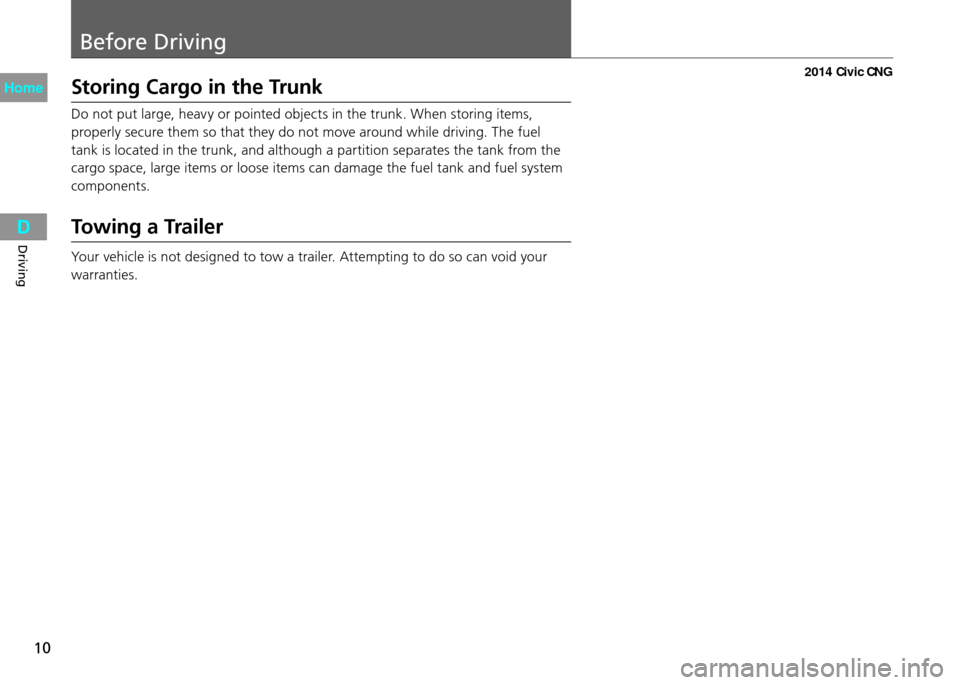
Before Driving
10
Driving
Storing Cargo in the Trunk
Do not put large, heavy or pointed objects in the trunk. When storing items,
properly secure them so that they do not move around while driving. The fuel
tank is located in the trunk, and although a partition separates the tank from the
cargo space, large items or loose items can damage the fuel tank and fuel system
components.
Towing a Trailer
Your vehicle is not designed to tow a trailer. Attempting to do so can void your
warranties.
2014 Civic CNG
Page 12 of 46
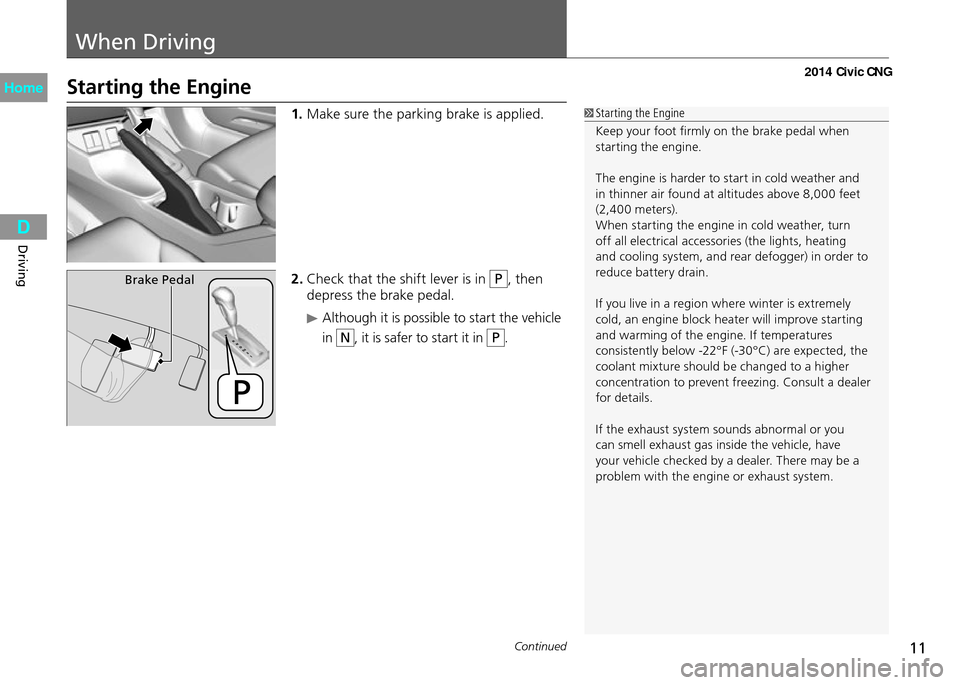
11
When Driving
Continued
Driving
Starting the Engine
Starting the Engine
Keep your foot firmly on the brake pedal when
starting the engine.
The engine is harder to start in cold weather and
in thinner air found at altitudes above 8,000 feet
(2,400 meters).
When starting the engine in cold weather, turn
off all electrical accessories (the lights, heating
and cooling system, and rear defogger) in order to
reduce battery drain.
If you live in a region where winter is extremely
cold, an engine block heater will improve starting
and warming of the engine. If temperatures
consistently below -22°F (-30°C) are expected, the
coolant mixture should be changed to a higher
concentration to prevent freezing. Consult a dealer
for details.
If the exhaust system sounds abnormal or you
can smell exhaust gas inside the vehicle, have
your vehicle checked by a dealer. There may be a
problem with the engine or exhaust system.
Brake Pedal
1. Make sure the parking brake is applied.
2. Check that the shift lever is in P
, then
depress the brake pedal.
Although it is possible to start the vehicle
in
N, it is safer to start it in P.
2014 Civic CNG
Page 13 of 46
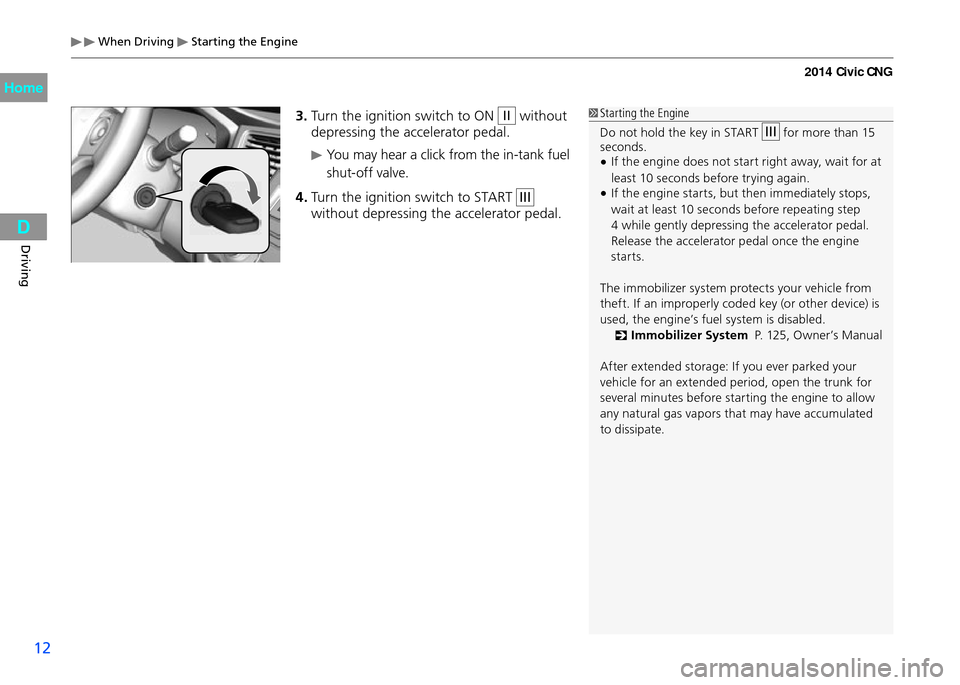
When Driving Starting the Engine
12
Driving
3. Turn the ignition switch to ON II without
depressing the accelerator pedal.
You may hear a click from the in-tank fuel
shut-off valve.
4. Turn the ignition switch to START III
without depressing the accelerator pedal.
Starting the Engine
Do not hold the key in START
III for more than 15
seconds.
If the engine does not start right away, wait for at
•least 10 seconds before trying again.
If the engine starts, but then immediately stops,
•wait at least 10 seconds before repeating step
4 while gently depressing the accelerator pedal.
Release the accelerator pedal once the engine
starts.
The immobilizer system protects your vehicle from
theft. If an improperly coded key (or other device) is
used, the engine’s fuel system is disabled. Immobilizer Syste m
P. 125, Owner’s Manual
After extended storage: If you ever parked your
vehicle for an extended period, open the trunk for
several minutes before starting the engine to allow
any natural gas vapors that may have accumulated
to dissipate.
2014 Civic CNG
Page 14 of 46
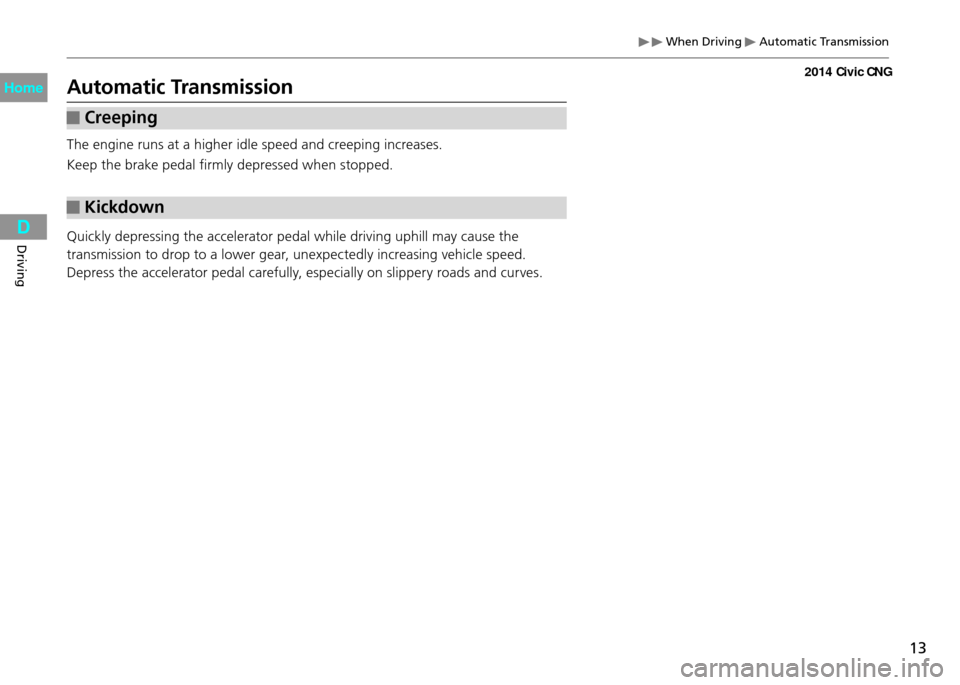
When Driving Automatic Transmission
13
Driving
Automatic Transmission
Creeping
The engine runs at a higher idle speed and creeping increases.
Keep the brake pedal firmly depressed when stopped.
Kickdown
Quickly depressing the accelerator pedal while driving uphill may cause the
transmission to drop to a lower gear, unexpectedly increasing vehicle speed.
Depress the accelerator pedal carefully, especially on slippery roads and curves.
2014 Civic CNG
Page 15 of 46
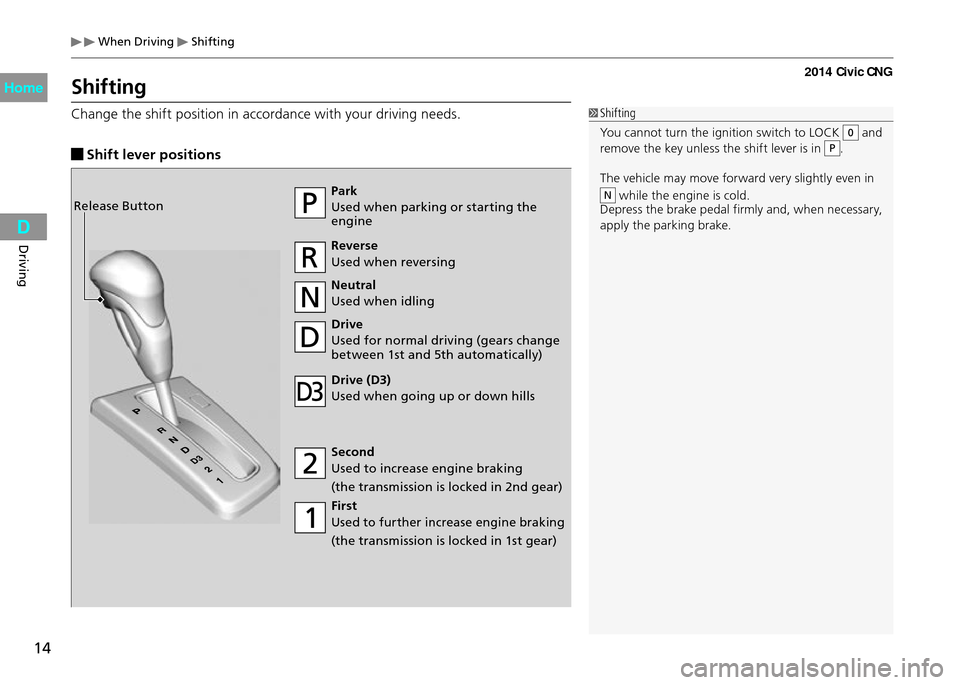
When Driving Shifting
14
Driving
Shifting
Change the shift position in accordance with your driving needs.
Shift lever positions
Park
Used when parking or starting the
engine
Reverse
Used when reversing
Neutral
Used when idling
Drive
Used for normal driving (gears change
between 1st and 5th automatically)
Drive (D3)
Used when going up or down hills
Second
Used to increase engine braking
(the transmission is locked in 2nd gear)
First
Used to further increase engine braking
(the transmission is locked in 1st gear)
Release Button
Shifting
You cannot turn the ignition switch to LOCK
0 and
remove the key unless the shift lever is in P.
The vehicle may move forward very slightly even in
N while the engine is cold.
Depress the brake pedal firmly and, when necessary,
apply the parking brake.
2014 Civic CNG
Page 16 of 46
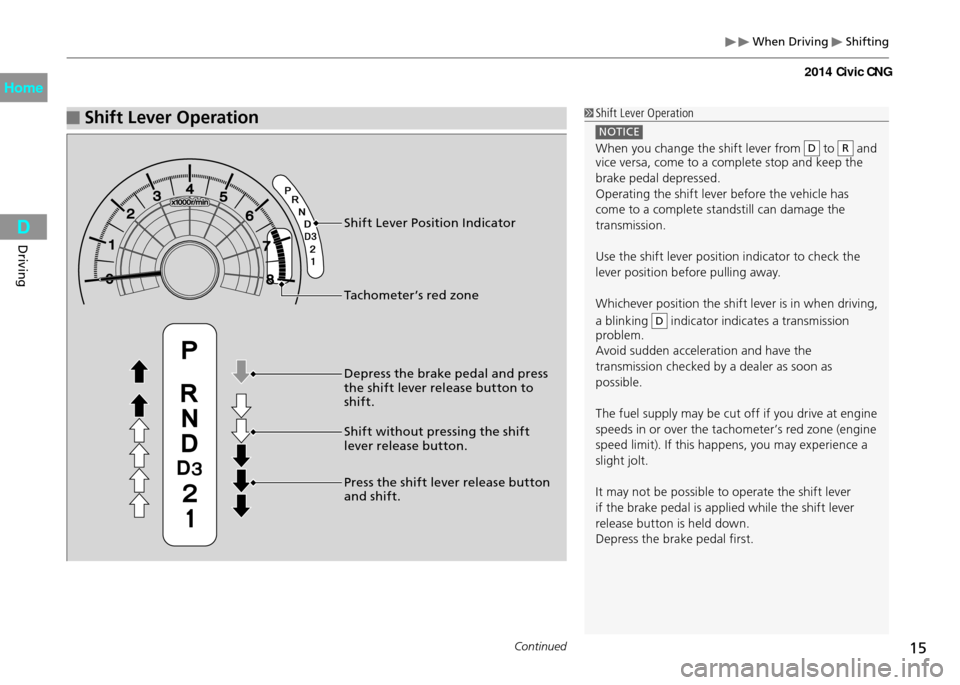
When Driving Shifting
15Continued
Driving
Shift Lever Operation
Shift Lever Position Indicator
Tachometer’s red zone
Depress the brake pedal and press
the shift lever release button to
shift.
Shift without pressing the shift
lever release button.
Press the shift lever release button
and shift.
Shift Lever Operation
NOTICE
When you change the shift lever from D to R and
vice versa, come to a complete stop and keep the
brake pedal depressed.
Operating the shift lever before the vehicle has
come to a complete standstill can damage the
transmission.
Use the shift lever position indicator to check the
lever position before pulling away.
Whichever position the shift lever is in when driving,
a blinking
D indicator indicates a transmission
problem.
Avoid sudden acceleration and have the
transmission checked by a dealer as soon as
possible.
The fuel supply may be cut off if you drive at engine
speeds in or over the tachometer’s red zone (engine
speed limit). If this happens, you may experience a
slight jolt.
It may not be possible to operate the shift lever
if the brake pedal is applied while the shift lever
release button is held down.
Depress the brake pedal first.
2014 Civic CNG
Page 17 of 46
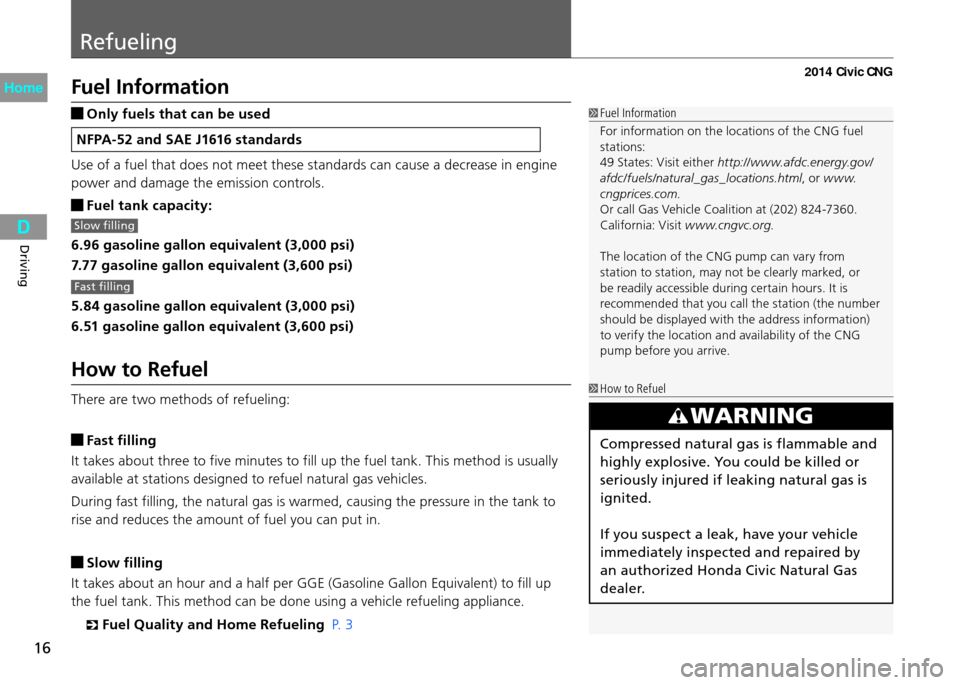
Refueling
16
Driving
Fuel Information
Only fuels that can be used
NFPA-52 and SAE J1616 standards
Use of a fuel that does not meet these standards can cause a decrease in engine
power and damage the emission controls.
Fuel tank capacity:
Slow filling
6.96 gasoline gallon equivalent (3,000 psi)
7.77 gasoline gallon equivalent (3,600 psi)
Fast filling
5.84 gasoline gallon equivalent (3,000 psi)
6.51 gasoline gallon equivalent (3,600 psi)
How to Refuel
There are two methods of refueling:
Fast filling
It takes about three to five minutes to fill up the fuel tank. This method is usually
available at stations designed to refuel natural gas vehicles.
During fast filling, the natural gas is warmed, causing the pressure in the tank to
rise and reduces the amount of fuel you can put in.
Slow filling
It takes about an hour and a half per GGE (Gasoline Gallon Equivalent) to fill up
the fuel tank. This method can be done using a vehicle refueling appliance.
Fuel Quality and Home Refuelin g
P. 3
Fuel Information
For information on the locations of the CNG fuel
stations:
49 States: Visit either http://w w w.afdc.energy.gov/
afdc/fuels/natural_gas_ locations.html , or www.
cngprices.com.
Or call Gas Vehicle Coalition at (202) 824-7360.
California: Visit www.cngvc.org.
The location of the CNG pump can vary from
station to station, may not be clearly marked, or
be readily accessible during certain hours. It is
recommended that you call the station (the number
should be displayed with the address information)
to verify the location and availability of the CNG
pump before you arrive.
How to Refuel
WARNING
Compressed natural gas is flammable and
highly explosive. You could be killed or
seriously injured if leaking natural gas is
ignited.
If you suspect a leak, have your vehicle
immediately inspected and repaired by
an authorized Honda Civic Natural Gas
d e a l e r.
2014 Civic CNG
Page 18 of 46
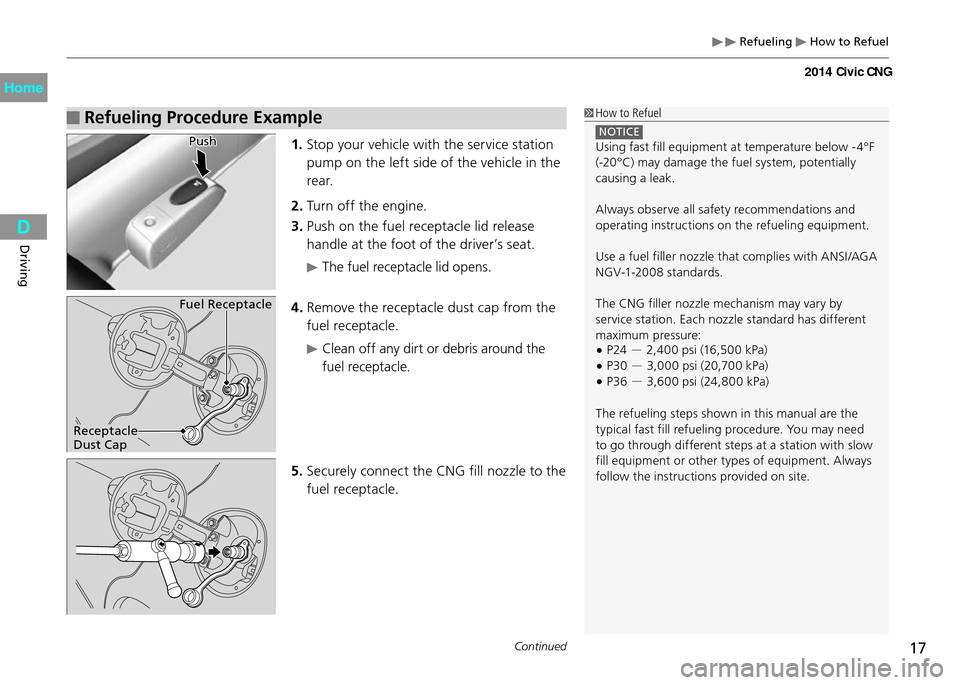
Refueling How to Refuel
17Continued
Driving
Refueling Procedure Example How to Refuel
NOTICE Using fast fill equipment at temperature below -4°F
(-20°C) may damage the fuel system, potentially
causing a leak.
Always observe all safety recommendations and
operating instructions on the refueling equipment.
Use a fuel filler nozzle that complies with ANSI/AGA
NGV-1-2008 standards.
The CNG filler nozzle mechanism may vary by
service station. Each nozzle standard has different
maximum pressure:P24
•- 2,400 psi (16,500 kPa)
P30
•- 3,000 psi (20,700 kPa)
P36
•- 3,600 psi (24,800 kPa)
The refueling steps shown in this manual are the
typical fast fill refueling procedure. You may need
to go through different steps at a station with slow
fill equipment or other types of equipment. Always
follow the instructions provided on site.
1. Stop your vehicle with the service station
pump on the left side of the vehicle in the
r e a r.
2. Turn off the engine.
3. Push on the fuel receptacle lid release
handle at the foot of the driver’s seat.
The fuel receptacle lid opens.
4. Remove the receptacle dust cap from the
fuel receptacle.
Clean off any dirt or debris around the
fuel receptacle.
5
. Securely connect the CNG fill nozzle to the
fuel receptacle.
Push
Fuel Receptacle
Receptacle
Dust Cap
2014 Civic CNG
Page 19 of 46
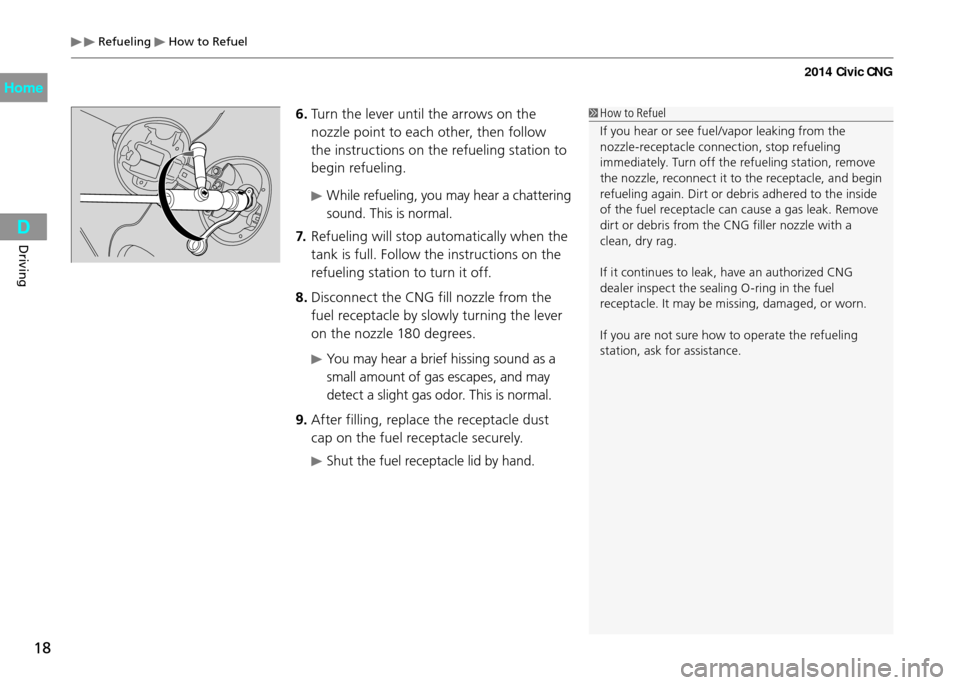
Refueling How to Refuel
18
Driving
How to Refuel
If you hear or see fuel/vapor leaking from the
nozzle-receptacle connection, stop refueling
immediately. Turn off the refueling station, remove
the nozzle, reconnect it to the receptacle, and begin
refueling again. Dirt or debris adhered to the inside
of the fuel receptacle can cause a gas leak. Remove
dirt or debris from the CNG filler nozzle with a
clean, dry rag.
If it continues to leak, have an authorized CNG
dealer inspect the sealing O-ring in the fuel
receptacle. It may be missing, damaged, or worn.
If you are not sure how to operate the refueling
station, ask for assistance.6. Turn the lever until the arrows on the
nozzle point to each other, then follow
the instructions on the refueling station to
begin refueling.
While refueling, you may hear a chattering
sound. This is normal.
7. Refueling will stop automatically when the
tank is full. Follow the instructions on the
refueling station to turn it off.
8. Disconnect the CNG fill nozzle from the
fuel receptacle by slowly turning the lever
on the nozzle 180 degrees.
You may hear a brief hissing sound as a
small amount of gas escapes, and may
detect a slight gas odor. This is normal.
9. After filling, replace the receptacle dust
cap on the fuel receptacle securely.
Shut the fuel receptacle lid by hand.
2014 Civic CNG
Page 20 of 46
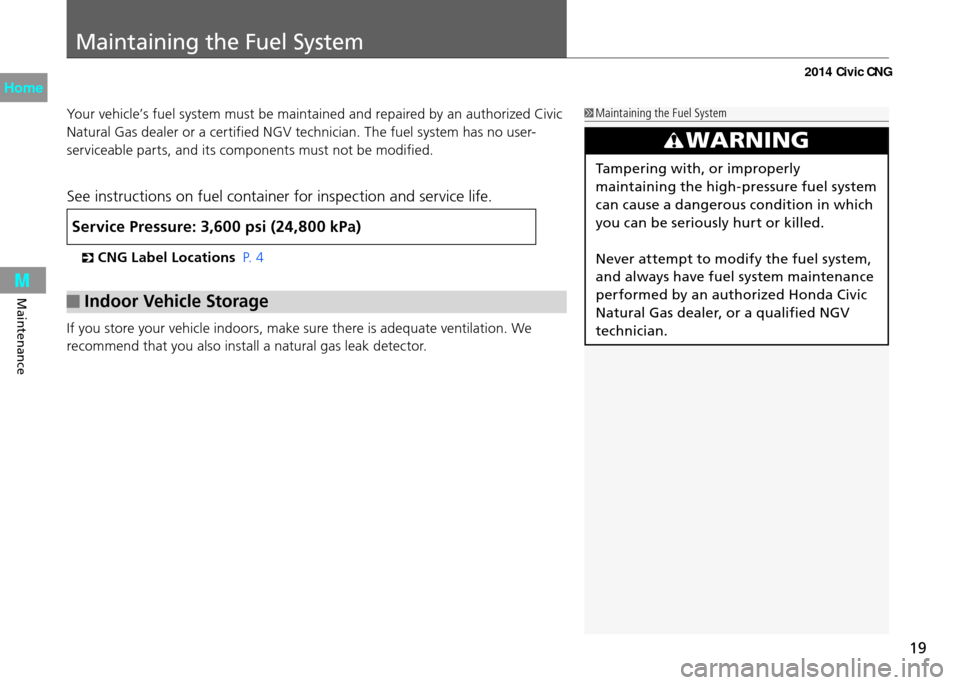
19
Maintaining the Fuel System
Maintenance
Your vehicle’s fuel system must be maintained and repaired by an authorized Civic
Natural Gas dealer or a certified NGV technician. The fuel system has no user-
serviceable parts, and its components must not be modified.
See instructions on fuel container for inspection and service life.
Maintaining the Fuel System
Service Pressure: 3,600 psi (24,800 kPa)
CNG Label Locations
P. 4
WARNING
Tampering with, or improperly
maintaining the high-pressure fuel system
can cause a dangerous condition in which
you can be seriously hurt or killed.
Never attempt to modify the fuel system,
and always have fuel system maintenance
performed by an authorized Honda Civic
Natural Gas dealer, or a qualified NGV
technician.
Indoor Vehicle Storage
If you store your vehicle indoors, make sure there is adequate ventilation. We
recommend that you also install a natural gas leak detector.
2014 Civic CNG